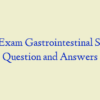Description
APEA Exam – ENDOCRINE with Answers
- A 45-year old female patient has fatigue for the past 3 months and a 10-pound weight gain. She previously has regular menses occurring about every 30 days, but in the last 3 months her menses has varied between 30 and 45 days. What explains this finding?
- A patient presents with consistently elevating blood glucose before his evening meal. What choice below represents an insulin change that would improve his evening glucose? Current AM regimen: 22u NPH, 12u short-acting insulin; Current PM regimen: 10u NPH, 8u short-acting insulin:
- An 80-year old patient who is overweight and sedentary has developed elevating fasting glucose levels (142, 153, and 147 mg/dL). She was diagnosed with diabetes today. Considering her age, how should the nurse practitioner proceed? Start metformin
- The most appropriate screen for diabetic nephropathy is:
- A patient with two fasting glucose values (121 mg/dL and 136 mg/dL) that were measured on 2 separate days in the same week. This patient:
- A 76-year old obese patient has fatigue, thirst, and frequent urination. She was asked to measure AM fasting glucose values for 1 week. The values range from 142-175 mg/dL. This patient:
- Common polyneuropathy in older adults is associated with:
- Which laboratory abnormality commonly accompanies hypothyroidism?
- Which medication listed below is NOT associated with weight gain?
- A normal fasting glucose in a nondiabetic patient is:
- A female patient has the following characteristics. Which one represents the greatest risk factor for the development of Type 2 diabetes?
- A patient who is 73 years old what diagnosed with diabetes several years ago. His A1c has remained elevated on oral agents and a decision to use insulin has been made. What is the goal of postprandial glucose for him?
- A patient has a TSH value of 13.1 today. The nurse practitioner has decided to initiate replacement with levothyroxine 88 mcg daily. When should the NP recheck the patient’s TSH level?
- A patient who has diabetes is taking pioglitazone (Actos). The nurse practitioner must remember to:
- A 60-year-old female patient had an initial TSH result of 7 mlu/L (normal = 0.4 – 3.8. mlU/L). Her repeat TSH and additional laboratory results are provided. What is the most likely diagnosis?
- A patient has been diagnosed with grave’s disease. He is likely to have:
- A pregnant patient took levothyroxine prior to becoming pregnant. What should be done about the levothyroxine now that she is pregnant?
- A 40-year-old patient with newly diagnosed type 2 diabetes asks what his targeted blood pressure should be. The most correct response in mm Hg is:
- The most appropriate time to begin screening for renal nephropathy in a patient with type 1 diabetes is:
- A nurse practitioner has decided to initiate insulin in a 75-year-old patient who take oral diabetic medications. How much long-acting insulin should be initiated in this patient who weighs 100kg?
- A 63-year-old male patient presents for evaluation of shortness of breath. His ekg demonstrates atrial fibrillation (a-fib). Which of the following laboratory studies should be LEAST helpful in the evaluation of the etiology of his symptoms? fasting lipids
- A 38-year-old male patient, thought to be in good health, presents to a primary clinic. On routine exam the patient’s fasting blood sugar is 242 mg/dL. A repeat value after eating is 288 mg/dL/ which of the following is least helpful in the initial evaluation of this patient?
- A patient has been diagnosed today with type 2 diabetes. A criterion for diagnosis is:
- A 38-year-old male patient presents for his annual exam. He reports nervousness and weight loss but denies any change in his dietary intake or exercise level. Based on these findings and the following lab values, what is his most likely diagnosis?




